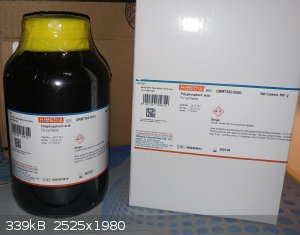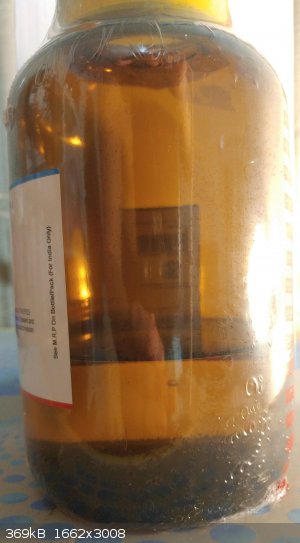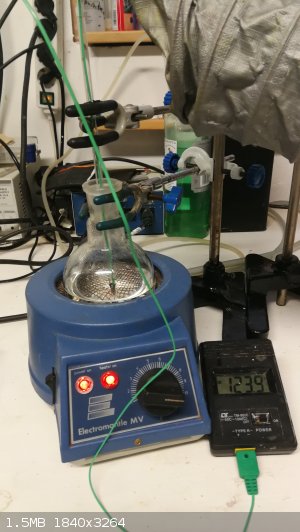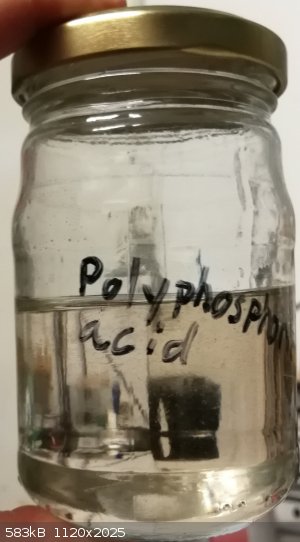| Pages:
1
2 |
Benignium
Hazard to Others
  
Posts: 115
Registered: 12-6-2020
Member Is Offline
Mood: Quasi-catatonic
|
|
Polyphosphoric acid
On my rather sketchy quest to synthesize methaqualone, the preparation I am following calls for something called polyphosphoric acid. Upon reading
further into it I learned that on heating regular old orthophosphoric acid eventually polymerizes into a viscous and sticky mess that is useful for
many things such as dehydration, alkylation and acylation, as well as inducing ring closure.
There seemed to be very little information on the procedure and a discouraging amount of what was there seemed to imply that glassware of any type
shouldn't be used. There is an old video on YouTube of someone transferring polyphosphoric acid. There is also a very useful thread here on Sciencemadness discussing the topic. Thank you especially to Woelen for the encouragement!
Due to the seeming scarcity of available information I decided to report on my success here in the hopes that my experience might be helpful to
someone else.
Nothing special about the setup. Just an electric heating mantle and 400 grams of 75% orthophosphoric acid in a 1000mL RBF. At about 254 degrees
celsius the acid stopped boiling but was still letting off fumes. At this point the liquid was still clear.

Later, at about 300 degrees, the contents turned opaque from what I assume is corrosion of the borosilicate. Sigma-Aldrich states 300 centigrade as
the boiling point of polyphosphoric acid and that's where the temperature decided to stop climbing. So I kept the flask at 300 for an arbitrary 30
minutes and called it a day. Despite this not a lot of product at all was lost to evaporation.

Once cooled, the phosphoric acid had indeed acquired a very thick, sticky consistency. This was particularly evident when emptying the flask into an
empty Nutella jar.

I inspected the flask after thoroughly rinsing it and initially it looked pretty rough. However, it looked a lot worse than it actually was.

I heated a mild solution of potassium hydroxide in the flask with stirring for a couple of hours and the white tumors and frostiness mostly chipped
away. Although considerably less opaque the glass is still visibly etched. The flask is still perfectly usable, though the quality (or lack thereof)
of any stir bar used is highlighted as the porous surface is prone to decoupling ones with a weak magnet.
I didn't take a proper picture after the KOH treatment, but the added clarity is evident in this picture that was taken during a subsequent bromine
synthesis:

So yes, it can be done with relative ease. And yes, borosilicate is suitable as long as any subsequent chemistry done isn't sensitive to the
phosphates from corroded borosilicate. I guess.
[Edited on 15-9-2020 by Benignium]
[Edited on 16-9-2020 by Benignium]
|
|
|
njl
National Hazard
   
Posts: 609
Registered: 26-11-2019
Location: under the sycamore tree
Member Is Offline
Mood: ambivalent
|
|
Interesting. What prep are you following that requires PPA?
|
|
|
Benignium
Hazard to Others
  
Posts: 115
Registered: 12-6-2020
Member Is Offline
Mood: Quasi-catatonic
|
|
Thanks! Here's the proposed preparation, taken from over here.
"7g Anthranilic Acid, 5ml o-Toluidine and 4 ml glacial acetic acid was mixed in a round-bottomed flask. To this mixture was slowly added 40-50 grams
of polyphosphoric acid, and the mixture was heated during 20-30 minutes to 140-160°C. After this, the mixture was heated to 180°C for 10 minutes,
then cooled and poured in 150-200ml water, and neutralized with 20% Na2CO3 solution. Methanol was added until a lasting turbidity became present in
the solution, and after one hour, the free base Methaqualone precipitated, mp 111-113°C, and was once more recrystallized in this fashion, mp
113-115°C. Yield 55%."
|
|
|
Corrosive Joeseph
National Hazard
   
Posts: 915
Registered: 17-5-2015
Location: The Other Place
Member Is Offline
Mood: Cyclic
|
|
/CJ
Attachment: Polyphosphoric Acid 1.pdf (118kB)
This file has been downloaded 622 times
Attachment: Polyphosphoric Acid As A Reagent in Organic Chemistry - Popp and McEwen (1957).pdf (3.9MB)
This file has been downloaded 518 times
Being well adjusted to a sick society is no measure of one's mental health
|
|
|
Benignium
Hazard to Others
  
Posts: 115
Registered: 12-6-2020
Member Is Offline
Mood: Quasi-catatonic
|
|
Awesome! Thank you @Corrosive Joseph
|
|
|
SuperOxide
Hazard to Others
  
Posts: 486
Registered: 24-7-2019
Location: Devils Anus
Member Is Offline
|
|
@Benignium - Thank you for sharing this! I was looking for data on the synthesis of polyphosphoric acid myself and running into the same limitations.
I haven't tried this yet, but I definitely plan on it, so thanks for making it easier on me :-)
|
|
|
Benignium
Hazard to Others
  
Posts: 115
Registered: 12-6-2020
Member Is Offline
Mood: Quasi-catatonic
|
|
You're very welcome, SuperOxide! 
|
|
|
zed
International Hazard
    
Posts: 2277
Registered: 6-9-2008
Location: Great State of Jefferson, City of Portland
Member Is Offline
Mood: Semi-repentant Sith Lord
|
|
Thank you Corrosive Joeseph. Nice references.
I have used PPA, and I am familiar with its preparation. But, I was unaware of most of its possible uses.
I have only used it, in an exotic Indole synthesis. It did not etch the glass, at the temperatures I employed.
Nice to see someone making it.
Such high heats, might not be required, if vacuum is utilized to aid in H2O removal.
Also noted, is the effect of the hot acid on glass. Lower heat might prove less destructive.
Since I have lots of glassware, if I decide to make some PPA, I will dedicate a sacrificial flask (beaker?).
Pretty thick. The stuff I used, was crystal-clear, and molasses thick.
Now that I think of it, the manufacturer must have supplied the product, in a wide-mouth jar.
I hadn't remembered that.
|
|
|
SuperOxide
Hazard to Others
  
Posts: 486
Registered: 24-7-2019
Location: Devils Anus
Member Is Offline
|
|
What did you use as the source of phosphoric acid? Did you buy straight phosphoric acid, or did you get it from an OTC source (eg: rust remover)? If
it's the latter, then did you have to extract the phosphoric acid first? (I would assume so).
P.S. You included two links in your original post, the first was to a YT video, and I think you meant to link to a SM thread in the 2nd one, but it
also links to the same YT video.
[Edited on 8-1-2021 by SuperOxide]
|
|
|
Benignium
Hazard to Others
  
Posts: 115
Registered: 12-6-2020
Member Is Offline
Mood: Quasi-catatonic
|
|
SuperOxide, phosphoric acid is perfectly OTC where I live. Check out brewing supply stores.
Sorry for the mistake with the links, and thanks for pointing it out. This is the thread I was talking about.
|
|
|
SuperOxide
Hazard to Others
  
Posts: 486
Registered: 24-7-2019
Location: Devils Anus
Member Is Offline
|
|
I see. Well I already have this Loctite Naval Jelly Rust Dissolver, and I was curious if it would work with that. The MSDS says it only has between 10-30% phosphoric acid by weight (though it seems to be closer to 30%, from what I hear), so I'm sure I would first
have to do some separation process of some sort, maybe distillation.
|
|
|
draculic acid69
International Hazard
    
Posts: 1371
Registered: 2-8-2018
Member Is Offline
|
|
Quote: Originally posted by Benignium  | On my rather sketchy quest to synthesize methaqualone, the preparation I am following calls for something called polyphosphoric acid. Upon reading
further into it I learned that on heating regular old orthophosphoric acid eventually polymerizes into a viscous and sticky mess that is useful for
many things such as dehydration, alkylation and acylation, as well as inducing ring closure.
There seemed to be very little information on the procedure and a discouraging amount of what was there seemed to imply that glassware of any type
shouldn't be used. There is an old video on YouTube of someone transferring polyphosphoric acid. There is also a very useful thread here on Sciencemadness discussing the topic. Thank you especially to Woelen for the encouragement!
Due to the seeming scarcity of available information I decided to report on my success here in the hopes that my experience might be helpful to
someone else.
Nothing special about the setup. Just an electric heating mantle and 400 grams of 75% orthophosphoric acid in a 1000mL RBF. At about 254 degrees
celsius the acid stopped boiling but was still letting off fumes. At this point the liquid was still clear.

Later, at about 300 degrees, the contents turned opaque from what I assume is corrosion of the borosilicate. Sigma-Aldrich states 300 centigrade as
the boiling point of polyphosphoric acid and that's where the temperature decided to stop climbing. So I kept the flask at 300 for an arbitrary 30
minutes and called it a day. Despite this not a lot of product at all was lost to evaporation.

Once cooled, the phosphoric acid had indeed acquired a very thick, sticky consistency. This was particularly evident when emptying the flask into an
empty Nutella jar.

I inspected the flask after thoroughly rinsing it and initially it looked pretty rough. However, it looked a lot worse than it actually was.

I heated a mild solution of potassium hydroxide in the flask with stirring for a couple of hours and the white tumors and frostiness mostly chipped
away. Although considerably less opaque the glass is still visibly etched. The flask is still perfectly usable, though the quality (or lack thereof)
of any stir bar used is highlighted as the porous surface is prone to decoupling ones with a weak magnet.
I didn't take a proper picture after the KOH treatment, but the added clarity is evident in this picture that was taken during a subsequent bromine
synthesis:

So yes, it can be done with relative ease. And yes, borosilicate is suitable as long as any subsequent chemistry done isn't sensitive to the
phosphates from corroded borosilicate. I guess.
[Edited on 15-9-2020 by Benignium]
[Edited on 16-9-2020 by Benignium] |
Would have been interesting to know the flasks weight before and after the
Polyphos boil and before and after the potassium hydroxide boil
|
|
|
Benignium
Hazard to Others
  
Posts: 115
Registered: 12-6-2020
Member Is Offline
Mood: Quasi-catatonic
|
|
Very good call, draculic acid69! Unfortunately it's too late for this particular experiment but an universally constructive comment nonetheless.
|
|
|
draculic acid69
International Hazard
    
Posts: 1371
Registered: 2-8-2018
Member Is Offline
|
|
Should you repeat your experiment please include this information as equipment degradation is also a factor in chemistry that is so often overlooked.
|
|
|
SuperOxide
Hazard to Others
  
Posts: 486
Registered: 24-7-2019
Location: Devils Anus
Member Is Offline
|
|
Quote: Originally posted by draculic acid69  | | Should you repeat your experiment please include this information as equipment degradation is also a factor in chemistry that is so often
overlooked. |
Agreed. I would rather a reaction fail and lose the reactants than I would sacrifice some of my glassware. Then again, I don't have much glassware, so
that's probably why.
I was going to try this reaction, but then when I saw that it kills the glassware and I could get 500g of pure PPA for the same price as a new RBB
flask, I just decided to get the PPA instead.
If the PPA was on one of DEAs naughty chemicals list, then perhaps I would be ok getting some new glassware instead, but that's just not necessary.
[Edited on 29-1-2021 by SuperOxide]
|
|
|
ChemTalk
Hazard to Self
 
Posts: 65
Registered: 13-12-2018
Location: United States
Member Is Offline
Mood: colloidal
|
|
Benignium, polyphosphoric acid looks like a very interesting compound. Isn't chemistry amazing? Thanks for sharing with us.
|
|
|
SuperOxide
Hazard to Others
  
Posts: 486
Registered: 24-7-2019
Location: Devils Anus
Member Is Offline
|
|
I cheated :-(
One of the goals of the project I plan on using this for was using only chemicals from the hardware store and are totally legal and easy to get
locally.
Obviously this is cheating (in regards to the local/availability one, this is totally legal and not a monitored chemical). But I got this for just a
little more than what I would spend replacing the flask that got etched away making this, and it's way more pure.

P.S. Don't let the size of the bottle fool you (as it did me)... 500g of PPA is actually only like 1/3rd of that bottle volume, lol.

[Edited on 1-2-2021 by SuperOxide]
|
|
|
rockyit98
Hazard to Others
  
Posts: 283
Registered: 12-4-2019
Location: The Known Universe
Member Is Offline
Mood: no mood is a good mood
|
|
if you have P2O5 aka P4O10 adding it to H3PO4 will turn it in to Polyphosphoric acid.
"A mind is a terrible thing to lose"-Meisner
|
|
|
SuperOxide
Hazard to Others
  
Posts: 486
Registered: 24-7-2019
Location: Devils Anus
Member Is Offline
|
|
Good tip, unfortunately I don't have either phosphoric acid or phosphorus pentoxide (though I do plan on getting some in the future).
I originally did plan on making the PPA myself starting with H3PO4, but since PPA was surprisingly easy to get and wasn't prohibitively
expensive, I just went the lazy route.
But I may try the H3PO4 + P4O10 route in the future if I need some.
|
|
|
Benignium
Hazard to Others
  
Posts: 115
Registered: 12-6-2020
Member Is Offline
Mood: Quasi-catatonic
|
|
Nice purchase, SuperOxide!
I'd like to point out that one flask can definitely be used for multiple batches, so I think it is economically very viable. Granted, it is not as
pure as industrially made material but the silicon phosphate particles do sink to the bottom over several months, increasing purity and leaving the
acid less opaque.
|
|
|
SuperOxide
Hazard to Others
  
Posts: 486
Registered: 24-7-2019
Location: Devils Anus
Member Is Offline
|
|
Quote: Originally posted by Benignium  | Nice purchase, SuperOxide!
I'd like to point out that one flask can definitely be used for multiple batches, so I think it is economically very viable. Granted, it is not as
pure as industrially made material but the silicon phosphate particles do sink to the bottom over several months, increasing purity and leaving the
acid less opaque. |
Well that's good. The opaque part did kinda throw me off. But I notice in your methaqualone thread that it does look like they've sank to the bottom
now that I look at it more closely.
[Edited on 4-2-2021 by SuperOxide]
|
|
|
RustyShackleford
Hazard to Others
  
Posts: 195
Registered: 10-12-2020
Location: Northern Europe
Member Is Offline
|
|
aprox 125ml of 85% orthophosphoric acid was heated on the maximum setting with a heating mantle.
The acid started boiling around 130C and vigorously boiled untill it reached a temperature of around 250C (from room temperature to this took about
1h), after which the bubbling became calmer.
After hitting 300C the heating mantle was adjusted to keep around that temp (max it hit was 307C) for 30min.
I let it cool to 60C and poured it into a small jar for temporary storage.
I determined the warm fluids (40C) density to be 1.965 g/cm3. (because using a volumetric pipette with the room temperature fluid would be impossible
since its too thick)
This density is equal to 109% H3PO4, where as commercial polyphosphoric is 115%. I may reheat this in order to achieve the desired density.
For me the etching of the flask was very very minimal. Its currently drying after being washed with hydroxide, but during the washing i could not see
any damage to the flask at all. The thick fluid product was completely clear too, no haze as OP had.
Im unsure if the product i produced contains enough polyphosphoric acid to be used as a reagent, im planning to test it by reaction of phenol and
benzoic acid. If any of you know of a better test, please let me know.


[Edited on 22-2-2021 by RustyShackleford]
|
|
|
karlos³
International Hazard
    
Posts: 1520
Registered: 10-1-2011
Location: yes!
Member Is Offline
Mood: oxazolidinic 8)
|
|
I liked the P2O5/85% H3PO4 reaction to make polyphosphoric acid.
Seems like the best way to produce a reliably functioning PPA for whatever reaction it is intended for.
|
|
|
RustyShackleford
Hazard to Others
  
Posts: 195
Registered: 10-12-2020
Location: Northern Europe
Member Is Offline
|
|
Quote: Originally posted by karlos³  | I liked the P2O5/85% H3PO4 reaction to make polyphosphoric acid.
Seems like the best way to produce a reliably functioning PPA for whatever reaction it is intended for. |
Yes without a doubt that is the best method to produce it, its clean, efficient and quantitative.
But thermal dehydration of phosphoric acid, if only to produce a usable (not pure) product, is more interesting for amateurs.
|
|
|
SuperOxide
Hazard to Others
  
Posts: 486
Registered: 24-7-2019
Location: Devils Anus
Member Is Offline
|
|
@RustyShackleford - Very nice! Thanks for sharing your procedure and photos.
|
|
|
| Pages:
1
2 |